
Free Airdrop Season 7 is LIVE! Answer fun questions or do simple tasks to earn rewards from the $30K BitDegree prize pool. Participate Now ! 🔥
Whether you’re a beginner just getting started with cryptocurrency or an experienced day trader, securing your assets is crucial. One of the best ways to achieve this is by using hardware wallets. Therefore, in today’s Trezor Safe 3 review, we’ll examine one of the most advanced technologies for keeping your crypto secure.
This specific model is a great improvement in terms of safeguarding assets compared to the previous hardware wallets, such as Trezor T. It introduces enhanced security features, including an EAL6+ certified Secure Element chip, which significantly elevates the device's protection capabilities.
That said, I will explain everything in greater detail, including Trezor Safe 3 supported coins, in the pros chapter of this review. This comprehensive analysis will help you understand why the Trezor Safe 3 stands out as a premier choice for cryptocurrency security.
Verdict at a glance: Trezor Safe 3 is one of the best cold hardware wallets on the market. The device supports over 1,000 digital assets and introduced a new EAL6+ certified Secure Element chip, designed to withstand brute-force attacks. In addition, the code is open-source. As a result, people can perform their own audit and see if they can trust the firmware. On the other hand, the design of Trezor Safe 3 might not be for everyone.
Pros
- Resistant to brute-force attacks
- Easy to set up
- Crypto-industry pioneer
- Supports 1,000+ digital assets
- Open-source code
- Affordable pricing
Cons
- Potentially uncomfortable design
- Plastic screen prone to scratches
Table of Contents
- 1. A Quick Word on Trezor
- 2. Trezor Safe 3 Review: PROS
- 2.1. Increased Safety Measures
- 2.2. A Wide Range of Supported Crypto Assets
- 2.3. Open-Source Design
- 3. Trezor Safe 3 Review: CONS
- 3.1. Interface and Build Design Concerns
- 4. Trezor Safe 3 Alternatives
- 4.1. Trezor Safe 3 VS Model T
- 4.2. Trezor Safe 3 VS Trezor One
- 4.3. Trezor Safe 3 VS Ledger Nano X
- 5. Trezor Safe 3 Price
- 6. How to Use Trezor Safe 3 Wallet?
- 6.1. How to Set Up Trezor Safe 3 Wallet?
- 6.2. How to Send Funds to Your Trezor Safe 3?
- 7. Conclusions
A Quick Word on Trezor
Before getting into all of the intricacies of this Trezor Safe 3 review, let's take a look at why this company is so respected.
Trezor is one of the oldest companies producing cold wallets, making it a crypto-industry pioneer. Founded in 2013, its first product, Model One, was released in 2014. With this much experience in the crypto world, Trezor has become a highly trusted hardware wallet developer within the community.
Currently, the company has more than 110 employees working to produce even better products. The founders, Stick and Slush, teamed up to create, advance, and revolutionize an entirely new industry. By 2018, Trezor had developed its second hardware wallet, Model T.
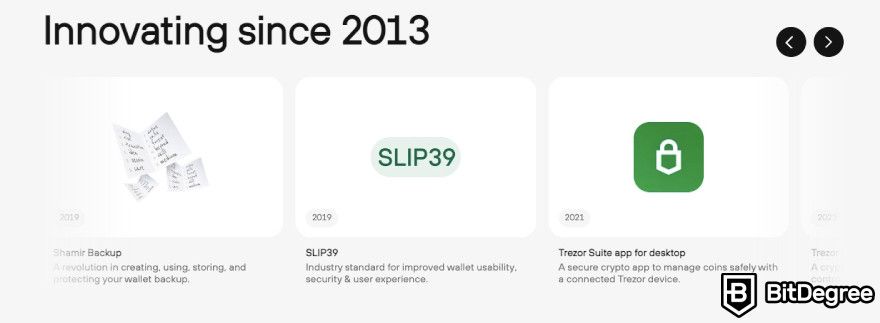
As of writing this Trezor Safe 3 review, the company has already released 4 different models. This demonstrates that the hardware wallets are of high quality and that users continue to purchase them. As a result, Trezor can sustain itself and keep producing even better products.
Trezor Safe 3 Review: PROS
Now, to continue this Trezor Safe 3 review, I will cover the benefits this hardware wallet has to offer, starting with the enhanced security features.
Increased Safety Measures
Because the previous Model T and One versions are vulnerable to brute-force attacks, one of the new features that Trezor introduced in its Safe 3 model to bolster its defense capabilities is a Secure Element.
A great example illustrating the necessity of such enhancements is when a security firm, Unciphered, managed to breach the well-known hardware wallet and extract both the seed phrase and the pin code by injecting malicious data. On the other hand, this requires physical access to your device, sophisticated equipment, and sufficient knowledge. Hence, the chances of someone pulling this off are extremely low.
The Secure Element is an EAL6+ certified chip designed to protect your PIN without storing it. This hardware ensures the safety of your recovery seed by securely saving it directly on the device. This feature also verifies the device’s authenticity during setup.
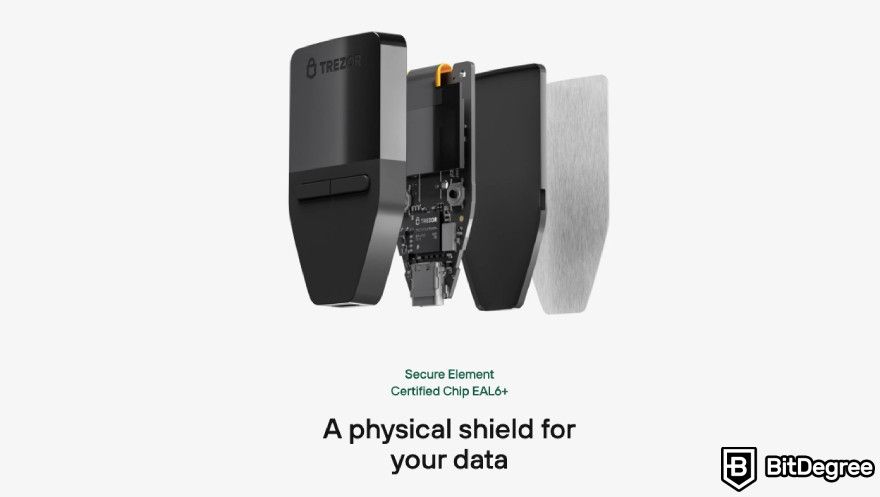
In addition, it is highly recommended that you purchase Trezor or any other hardware wallets directly from their official website, possibly using Trezor Safe 3 voucher codes for a better price. This is because malicious actors can tamper with the product, compromising the security of your device.
It’s also important to highlight that the hardware wallet is supposed to come with a holographic seal that makes sure your device hasn’t been messed with while it’s on its way to you.
Moreover, the Trezor Safe 3 offers great backup options. These include the standard 12-, 20-, and 24-word recovery seeds, as well as the advanced Shamir Backup (SLIP39), which splits the recovery seed into multiple shares[1], adding an extra layer of security. That said, if money is not an issue for you and you'd like a hardware wallet that provides even more protection, I would recommend checking out the Trezor Safe 5 model.
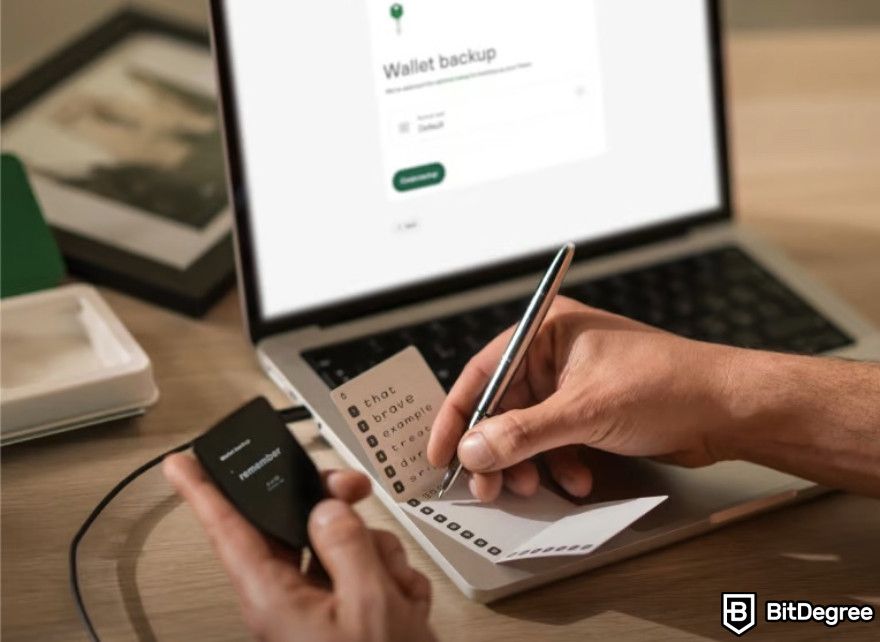
Furthermore, as you may or may not know, to fully set up and utilize this device, you will need an application called Trezor Suite. One notable feature of this software is its integration with the Tor network, which will anonymize your internet traffic. By activating it, you can ensure that your transactions made through platforms like Kraken or Binance remain hidden from prying eyes.
Trezor Suite also offers other advanced security features, such as a View-only mode, which allows you to monitor your balance without needing your Trezor or your private keys. It works by tracking the wallet extended public key (XPUB), which gives information about address holdings.
Lastly, for some people protecting the device itself can also be important. Hence, for extra safety on the outside, users can also purchase the Trezor Safe 3 case.
A Wide Range of Supported Crypto Assets
Needless to say, security is one of the most important aspects of hardware wallets, which is why this Trezor Safe 3 review covers it. However, considering the number of countless different coins and tokens on the market, I believe that most readers will agree with me that another important factor is how many crypto assets the device supports.
That said, when it comes to Trezor Safe 3 supported coins, it’s not an issue. The hardware wallet supports over 1,000 digital assets, including the most popular ones like Bitcoin, Ethereum, and Litecoin. In addition, it can handle ERC-20 tokens. As a result, it opens up compatibility with thousands of different digital assets.

Moreover, the Trezor Safe 3 supported coins list extends its compatibility through third-party wallet integrations. Also, while it doesn't directly connect to exchanges like Binance and Bybit, users can securely transfer their assets from these exchange platforms to their Trezor wallet, ensuring their funds are safe.
Additionally, if Bitcoin is the only cryptocurrency in your portfolio and you need only a hardware wallet to safeguard it exclusively, there is a version of Trezor Safe 3 specifically for that. This model is tailored to simplify Bitcoin storage and transactions, providing a streamlined and focused security solution.
Latest Ledger Nano X Coupon Found:For a limited time only, get Top-rated Ledger bundles for yourself and your loved ones with a 10% Ledger discount code. Take advantage of this valuable Ledger deal NOW!
Open-Source Design
Another important fact to mention in this Trezor Safe 3 review is that, like its predecessors, this hardware wallet uses a public, open-source code design. The developers have stated that they worked hard to integrate the Secure Element without sacrificing the transparency of their device.
In addition, the company has also managed to source the OPTIGA Trust M (V3) chips from a producer that does not restrict them from freely publishing potential vulnerabilities.
The great thing about the wallet having an open-source code is that everyone is able to perform an audit. This openness allows for a collective effort to ensure the security and integrity of the wallet. Independent developers and security experts can review the code, identify potential flaws, and suggest improvements. This collaborative approach significantly enhances the wallet's security, as it is not reliant on a single entity to identify and fix issues.
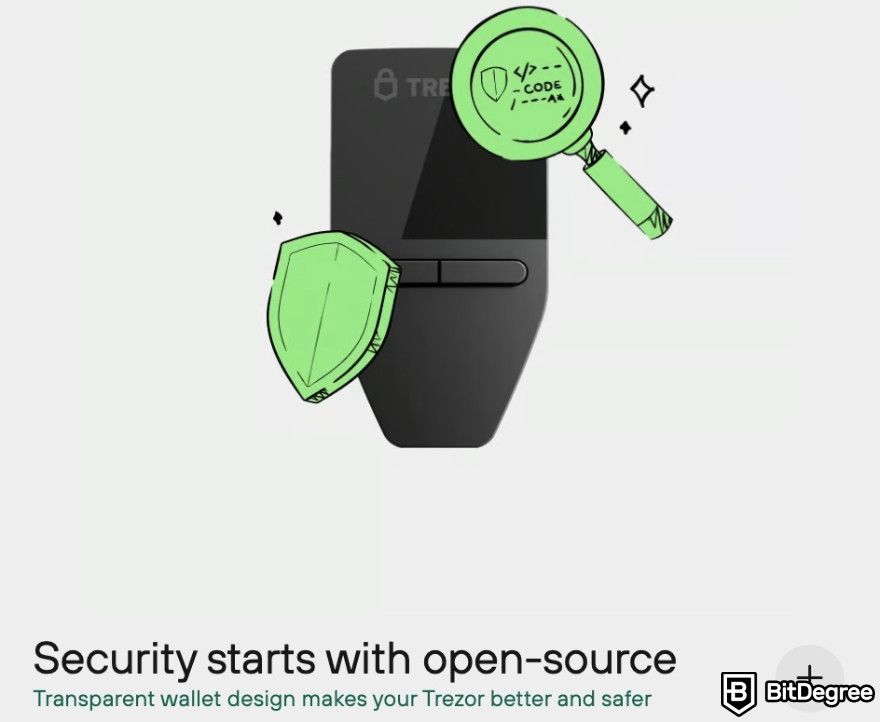
Moreover, this further demonstrates the safety of this wallet, as a flawed code would deter people from purchasing Trezor products. This transparency is crucial in the cryptocurrency world, where trust and security are paramount.
Another benefit of open-source hardware wallets is the rapid pace of innovation. Developers from around the world can contribute to the project, adding new features and improvements at a much faster rate than a closed-source project[2]. This means users of the Trezor Safe 3 can benefit from cutting-edge security practices and the latest technological advancements.

Did you know?
All Crypto wallets may look similar to you but they're NOT all the same!
Trezor Safe 3 Review: CONS
By this point, we have covered the most notable benefits of this wallet. However, while doing research, I noticed that some user Trezor Safe 3 reviews had complaints. Therefore, to make this article fully transparent, let's examine the not-so-good parts.
Interface and Build Design Concerns
If you are familiar with the previous versions of this hardware wallet, you will know that the Model One had two buttons instead of a touchscreen. The same is true for the Trezor Safe 3. The design itself is very similar to the first version. As a result, some user Trezor Safe 3 reviews mention complaints about its ease of use.
That said, this is not a “groundbreaking” issue and is more subjective, depending on your needs. On one hand, if you need to access your wallet frequently, having a touchscreen would save you some time. On the other hand, if you only need it occasionally, this shouldn’t raise too many issues.

Another issue that seems to appear in user Trezor Safe 3 reviews is the durability of the device, particularly because its screen is made from plastic material and is therefore prone to scratching, unlike the newer Safe 5 version, which features a Gorilla Glass screen for enhanced resilience.
Lastly, I noticed one more complaint while reading user reviews. The Trezor Safe 3 case seemed to have a production defect, which is most likely already fixed at the moment of writing. Nonetheless, it’s worth noting that some users had issues with the bumper case, as they couldn’t charge the wallet while it was on due to its bulkiness.
Trezor Safe 3 Alternatives
While the Trezor Safe 3 is a top-notch hardware wallet with great security features, it’s always good to explore other options to ensure you’re making the best choice for your needs. There are several other reputable devices on the market, each with its own unique features and benefits. Therefore, in this Trezor Safe 3 review chapter, we will examine some of the top alternatives to this hardware wallet.
Trezor Safe 3 VS Model T
When it comes to the matchup of Trezor Safe 3 VS Model T, the most noticeable difference is the Secure Element. As mentioned previously, the former doesn’t have the chip, designed to protect the wallet from brute-force attacks. Therefore, security-wise Trezor Safe 3 model may seem like a safer option.
That said, the Model T includes an SD card slot, which provides an extra layer of security by encrypting the microSD with a PIN. This feature ensures that the device is bound to the card, making it unusable without it.
Moreover, another key difference between these two wallets is the design. The Model T is a little bit bigger and has a touchscreen, whereas the newer Safer 3 version has a similar design to that of Model One, having two buttons to execute actions and a monochromatic OLED screen.

The last thing to consider in this Trezor Safe 3 VS Model T comparison is the cost. The former is notably cheaper than the latter, making it a more affordable option for users who do not need a touchscreen.
To summarize, when comparing the Trezor Model T VS Safe 3, everything comes down to the price. However, if you want to ensure your hardware wallet is safe from brute-force attacks, the newer version is more secure.
Trezor Safe 3 VS Trezor One
Evaluating the Trezor Safe 3 VS Trezor One, several key differences highlight why the newer model stands out. The first significant distinction is the Secure Element chip. The Trezor Model One lacks this hardware piece, which means it doesn’t provide protection against brute-force attacks as the newer version does.
Another noticeable difference between the Trezor Safe 3 VS Trezor One is the type of port each uses. The latter is equipped with a Micro USB connection, while the former uses a USB-C. Considering that the majority of today’s technology utilizes a USB-C port, not having it can be quite burdensome and even look outdated. On the other hand, it needs to be taken into account that the Model One wallet was released in 2014.
Considering the Trezor Safe 3 supported coins, the competitor, in this case, performs a bit worse. If you are interested in having Solana, ADA, XRP, or Monero in your portfolio, unfortunately, the Model One hardware wallet does not support them.
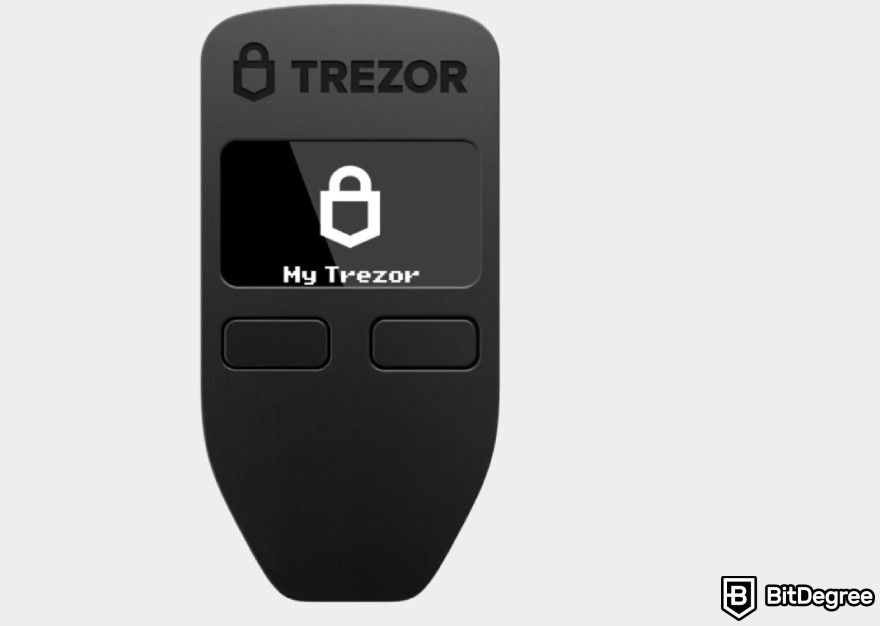
Moreover, I have already mentioned in this Trezor Safe 3 review that this model includes Shamir Backup, a feature that Trezor One doesn’t have. Which means that the older version is not as safe as the newer one.
Finally, in the Trezor Safe 3 VS Trezor One comparison, the last difference to mention, which for some might be a deal-breaker, is compatibility with iOS devices. The latter does not work with the iOS operating system. For users who use Apple mobile devices, this could significantly impact their decision on which hardware wallet to choose.
Overall, comparing the Trezor Safe 3 VS Trezor One reveals that the newer model emerges as the better option due to its Secure Element chip, USB-C connectivity, broader cryptocurrency support, Shamir Backup feature, and iOS compatibility.
Trezor Safe 3 VS Ledger Nano X
I believe it's fair to say that both Ledger and Trezor make the best hardware wallets. Therefore, let's compare the Safe 3 and Nano X models.
First, the Ledger Nano X stands out because it has a built-in battery. This means that users can access their assets without needing to connect the device to a power source. As a result, allowing for greater mobility and convenience.
Moreover, both Trezor Safe 3 and Ledger Nano X use buttons for navigation. However, the former has a bigger screen, making it somewhat easier to navigate, as it provides clearer visibility of transaction details.

Another significant difference is that the Nano X comes with Bluetooth functionality. This means the device can connect wirelessly to smartphones and other devices. On the other hand, this feature raises some security concerns among users who prefer a completely offline hardware wallet to minimize potential vulnerabilities.
Additionally, one of the key points already mentioned in this Trezor Safe 3 review is the open-source nature of its code. Because of this, the community can audit and contribute to the development of the hardware wallet, potentially enhancing the device’s security and trustworthiness.
Meanwhile, the Ledger Nano X uses closed-source code, which some users may find less reassuring since they cannot independently verify the software’s integrity.
The last difference between these two hardware wallets is the price. Currently, the Ledger Nano X price is $149. Compared to the Trezor Safe 3, which costs only $79, that’s quite an increase.
Trezor Safe 3 Price
I have covered all of the wallet's important aspects, features, and functionalities, except for one: the price. Strangely enough, while doing research, I noticed that not many user Trezor Safe 3 reviews mention the pricing of this wallet. Leaving out this factor is surprising, considering how affordable the device is.
As of writing this Trezor Safe 3 review, the hardware wallet stands at $79. It’s worth highlighting that this model is among the most affordable they offer, even though it is one of the newest. The only Trezor hardware wallet that you can purchase for a lower price is the Trezor Model One.

This is even more surprising when taking into account that the Model T is a much older version and does not have the Secure Element chip.
The Trezor Safe 3’s price is competitive when considering its features and the broader market. Competitors often price similar hardware wallets higher without providing the same level of security or user experience. Additionally, if you would like to purchase this device at a better price, you can find some Trezor Safe 3 voucher codes.
Upon purchasing this hardware wallet, you receive the device, a USB-C to USB-C cable, two wallet backup cards, a start-up guide, and some stickers. Moreover, it’s worth mentioning that users can purchase a bumper for only $10. This Trezor Safe 3 case will ensure your device stays completely safe from any fall damage or scratches.
How to Use Trezor Safe 3 Wallet?
To finish off this Trezor Safe 3 review, I will provide you with quick steps on how to set up the hardware wallet and how to move your assets.
How to Set Up Trezor Safe 3 Wallet?
Below, you will find step-by-step instructions on how to set up the Trezor Safe 3 hardware wallet.
Step 1: Connect your Trezor Safe 3 to your computer using a USB cable. Once connected, navigate to the Trezor website and download the Trezor Suite software.

Step 2: After opening Trezor Suite, you may be prompted to install the latest firmware on your device. Click “Install firmware” and wait for the process to complete.
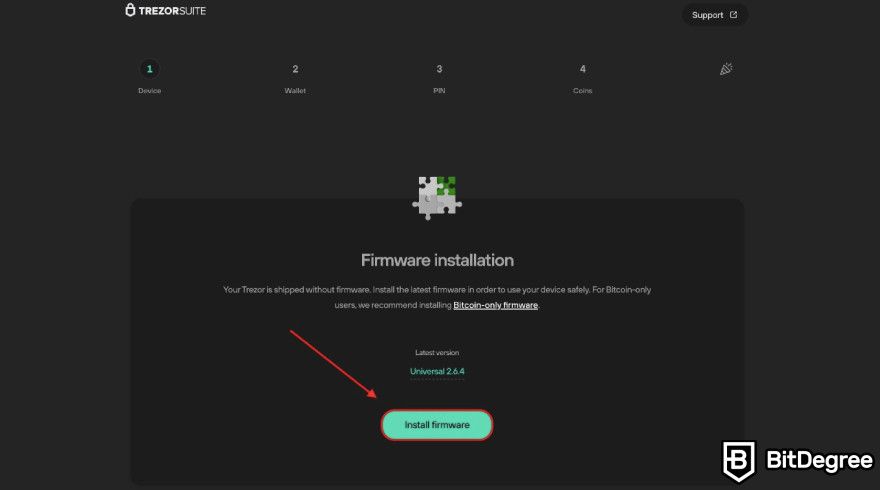
Step 3: Next, you will see options to create a new wallet or recover an existing one.

Step 4: After setting up your wallet, your device will display a recovery seed, a series of 12 or 24 words. Write them down on the provided recovery seed card. It’s important that you do not store the words digitally or share them with anyone.

Step 5: When you finish writing down your recovery seed, you will be asked to confirm it. This involves selecting the words displayed on the device in the correct order.
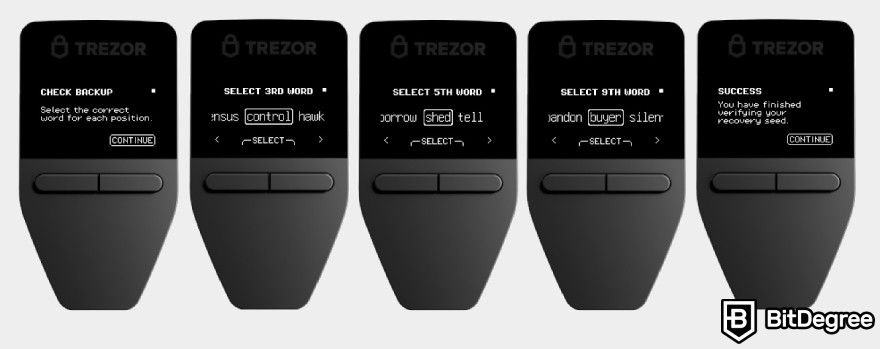
Step 6: Lastly, you will be prompted to set up a PIN for your Trezor Safe 3, which can consist of up to 50 digits.
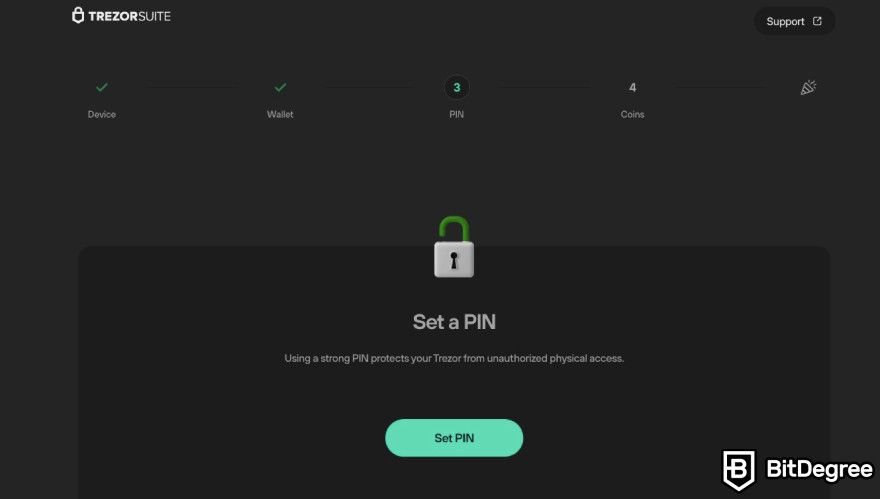
That said, after completing these steps you will be fully set to utilize the hardware wallet.
How to Send Funds to Your Trezor Safe 3?
Before getting started, let me mention that it’s recommended to withdraw your coins from trusted exchange platforms such as Binance or Kraken. To do this, you need to create a secure address to withdraw your funds to, which involves just a few steps:
Step 1: Navigate to the account where you want to receive the cryptocurrency. Click on the "Receive" button in the account menu bar.
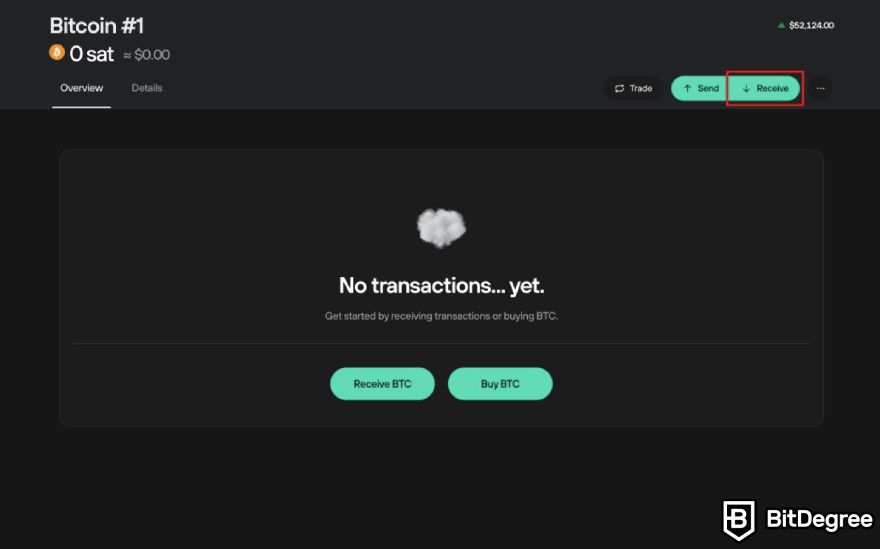
Step 2: Click "Show full address." Your Trezor device will display a new receiving address. Ensure that the address shown on Trezor Suite matches the address displayed on your Trezor device.

Step 3: Copy the receiving address to your clipboard. You can also use the provided QR code if supported by the exchange.
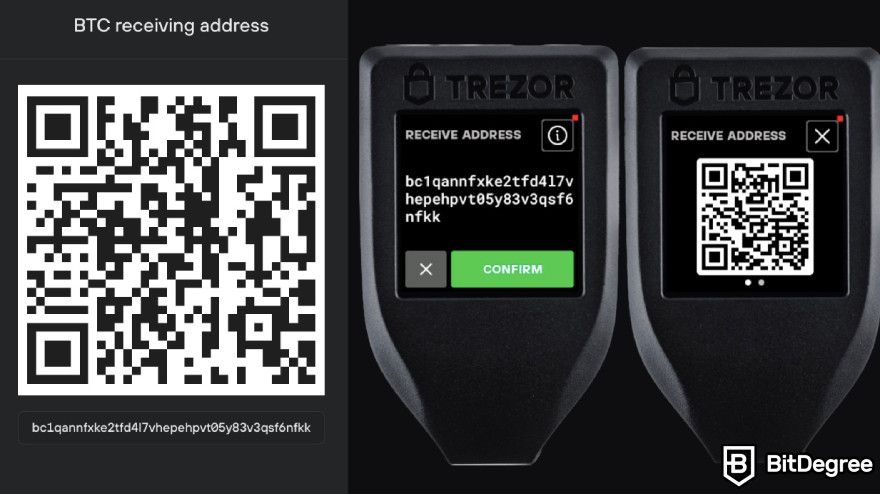
Step 4: Go to the exchange or wallet where your cryptocurrency is currently stored. Initiate a withdrawal and paste the copied address or scan the QR code as the destination address.
Step 5: Double-check the address to ensure it is correct. Confirm the transfer on the exchange or wallet platform to send your assets to Trezor Safe 3.
Lastly, after the transaction is complete, verify the received funds in your Trezor Suite account to ensure they have arrived safely.
Conclusions
Concluding my Trezor Safe 3 review, I can confidently say that this hardware wallet is one of the best on the market. If you want your digital assets kept secure, this device will definitely be a great investment.
Moreover, transfers from exchange platforms like Binance, Kraken, or Bybit are simple and straightforward, thanks to the wallet’s firmware and the streamlined design of the software. In addition, let me once more highlight that the Trezor Safe 3 is not only a cold wallet, which means that hackers have no access to it. It now also includes a Secure Element chip that protects it from brute-force attacks.
That said, I hope this review was helpful and you were able to find everything you wanted to know. Lastly, if you are planning on purchasing the wallet after reading this article, don’t forget that there are great Trezor Safe 3 voucher codes that could save you money.
The content published on this website is not aimed to give any kind of financial, investment, trading, or any other form of advice. BitDegree.org does not endorse or suggest you to buy, sell or hold any kind of cryptocurrency. Before making financial investment decisions, do consult your financial advisor.
Scientific References
1. A. Bissoli., F. d'Amore.: 'Authentication as A Service Based on Shamir Secret Sharing';
2. P. R. Bassi., G. M. P. Wanderley., P. H. Banali., et al.: 'Measuring Developers' Contribution in Source Code using Quality Metrics'.





